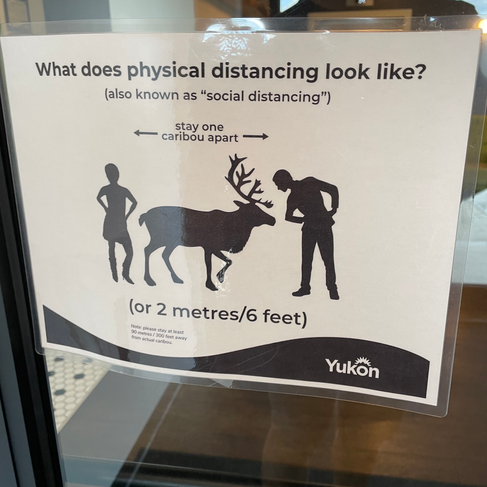What a Rush
- Siobhan
- Jul 12, 2022
- 4 min read
Leg 6: Lake Watson, Yukon to Whitehorse, Yukon
8 July 2022
Corbin woke up post-fever feeling chipper as a chipmunk after a long NyQuil assisted night of sleep. I cleaned up the campsite while Corbin made coffee and tea while wearing his Mosquito smock. Once the tent was down, I quickly helped Corbin clean up the rest of camp and we hightailed it out of Watson Lake by 8am! So Long, 'skeeters!

At the first gas station we passed, we stopped and met a kind Yukon man with three dogs that gave us some much needed pet therapy. When speaking, the man shouted instructions at us from behind the counter inside his store: “ONLY CASH OR VISA.” When Corbin had trouble figuring out the gas pump: “PULL UP THE LEVER THAT THE HANDLE SITS ON.” And still when I went inside and asked to buy the ice out of the cooler outside that said "Ice": “WE DON'T HAVE ANY ICE IN THAT COOLER. NO ROOM FOR IT INSIDE AND NO POWER.” It was lovingly comical.
As the day went on, we noticed that the rural gas station was not the only place that had instructions indicating only "Cash or Credit--No Debit" and we figured this was a middle-of-nowhere Yukon quirk. However, we later learned when watching the news that this was actually due to a nationwide internet outage in Canada by Rogers Wireless. The outage caused millions of users to not be able to call 911 or withdraw cash from ATMs among other necessities and ended up lasting over three days for some customers. Fortunately, we had credit cards and plenty of Canadian cash so we weren't affected.
Our drive to Whitehorse was thankfully only 5 hours, so we arrived around 1:30pm. Since Corbin was feeling better, we decided to explore (outside!) the nearby Miles Canyon, which was a very short drive from town.
Miles Canyon was phenomenal! Miles Canyon, named in 1883 after an American military general, was originally known as Kwanlin "running water through canyon" by the First Nations. Today, one of the First Nations in the Whitehorse area are known as the Kwanlin Dün taking their name from the canyon (the other main First Nations people that live in the Whitehorse area are the Ta’an Kwäch’än.)

The canyon was created from water rushing through hardened basaltic lava (a type of igneous rock) a very, very long time ago over many, many years (this is the simplified science version that I tell myself in order to understand; I apologize to those of you more proficient in geology and volcanology!) During the Klondike Gold Rush, many boats navigated the rapids in order to advance on their gold-finding journey in the land north of Whitehorse.
Miles Canyon (look for the bear paw print in one of pics!)
At the canyon, we admired the beautiful, turquoise waters while hiking a nature loop throughout the vast park. I was a bit nervous after seeing a bear paw print on one of the trails since we had forgot our bear spray in the car. Luckily, the only animals we saw were some birds and a very irritated squirrel who furiously squeaked at me when I unknowingly got too close. The park was also having an event that day called "Created at the Canyon," which had various artists---a guitarists, water color painters, sketch artists, quilters, and others---creating art while people observed casually and chatted with them about their craft. It was awesome to see and led us to learn about the large art presence in Whitehorse.
Back in town, we checked into our hotel (there was a nice back entrance with little to no people that Corbin and I used!) and then walked around downtown Whitehorse. Whitehorse, named after the turbulent Miles Canyon rapids that resembled "white horses," is the capital city of Yukon and grew from the dreamers hoping to strike it rich in the Klondike. As we walked around, we were surprised to find vibrant breweries and restaurants dotting the town where locals and travelers ate outside. Corbin and I both think Whitehorse will be an up-and-coming city in the next few years (if it isn't already) with the amount of whitewater activities, hiking, and breweries/cafés around---a millennial's paradise.
Awesome Street Bike Lockers & the Social Distancing Sign in Our Hotel

[Corbin had a problem with the above statue because the fellow is most likely supposed to represent a Klondike Gold Miner and the majority of gold seekers followed their dream of finding gold and "did not strike it rich but instead failed miserably, died, got sick, abandoned their families" ect. Thank you, Corbin.]
When walking along the waterfront, we saw the Whitehorse Indian Mission School Memorial. The memorial was a circle of nine wooden stools to represent a seat for indigenous people who attended the schools to talk about their grief with a small opening at one end. The opening represented an encouragement to others who did not attend Indian Residential Schools to talk and acknowledge the tragedies that occurred at residential schools in Canada from the 1800s through the 1990s. In a later post, I will write more about the horrors of residential schools on the First Nations people and what we learned.
After our evening jaunt, we hid in the hotel room fairly early because we were exhausted and ordered room service----a first for Corbin! After two nights of nonstop mosquitoes, the simple pleasures of a hot shower, no bugs, and a bed were unbelievably rewarding!



























Comments